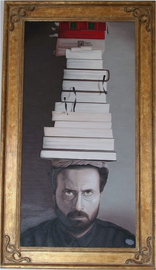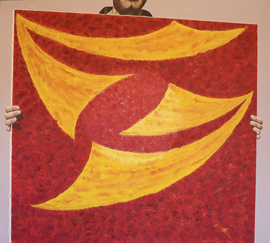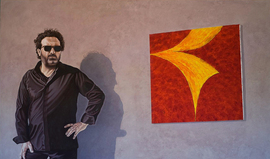Biography and comments
Alessandro Palozzi's Works focus on the meta-linguistic of Painting. This artist is deeply involved in that particular ambit of visual art where the enigma leads his iconic code towards a puzzling, overexcited and unexpected mental/intellectual room. His aesthetics move from Focault's paradox concerning the famous Velasquez painting Las Maninas, where wiever and painted character both take part in the same scene: There's always a misterious outflow somewhere in their paintings, that whirls the wiever's eye and projects it into a further and hidden dimension. The trick of a visual trap always lays behind (and beyond) the painted image; The Wiever's Eye is reeled and rounded by a continuous jeu des ricochets. Only by the means of an Analitic Eye we realize that his images are describing (and commenting) the painting practice: Exhibiting a finished artcraft reveals the ephemeral nature of mimetic effort. Alessandro Palozzi 's painting goes beyond objectivity of figurative art; his images aren't another way to please the eye, but they always illustrate and comment the same absolute A-Temporal process. His works act-out a kind of narration, that at a deeper level of analysis reveals the artist's Visual Philosophy, maybe his Weltschaung.

One of Alessandro Palozzi's firsts painting is a self-portrait with a pile of philosophical treaties on his head. Those books could be referred to the philosophical content of visual artworks, but Palozzi is also joking with the heavy (material) weight of Western Thought tradition.
When Alessandro Palozzi produces a self-portrait, carrying an abstract painting in his hands, or on the wall beside him,  he's enacting a tautology.
His self-portrait, painted in neuter colors, almost grisaille, displays (and comments) a mental zone and, otherwise, the colored and materic depict testifies and reverberates his emotional and sensuous side.
he's enacting a tautology.
His self-portrait, painted in neuter colors, almost grisaille, displays (and comments) a mental zone and, otherwise, the colored and materic depict testifies and reverberates his emotional and sensuous side. This artist acts-out a sort of culinaire panting: he's free from the tyranny of figurative art and his productions are centred on the evocative fascination of narrating surfaces.
Alessandro Palozzi's paintings mantain their semantic ambiguity; They're both art tools, artistic devices, and a
surface occopational practice.
When Alessandro Palozzi depicts three exhibitions of contemporary art vedettes he delves into institutional Critique and parodies art-biz, in displaying celebration of success as their one and only vertigo.
Palozzi's tricks find their reason of being in disappearing.
He works using ironic characters and also referring to the higer western Pictorial Tradition.
This artist acts-out a sort of culinaire panting: he's free from the tyranny of figurative art and his productions are centred on the evocative fascination of narrating surfaces.
Alessandro Palozzi's paintings mantain their semantic ambiguity; They're both art tools, artistic devices, and a
surface occopational practice.
When Alessandro Palozzi depicts three exhibitions of contemporary art vedettes he delves into institutional Critique and parodies art-biz, in displaying celebration of success as their one and only vertigo.
Palozzi's tricks find their reason of being in disappearing.
He works using ironic characters and also referring to the higer western Pictorial Tradition.
Quoting Alessandro Palozzi's thoughts on Art
- "Painted figures are not in conflict with pure research for forms and colors; they (the figures, n.d.t.) transform the content the same way colors alter the value of shapes and patterns";
- "Art is not representing. Using signs and symbols unveils and reverberates a hidden reality that stands before and beyond knowledge;"
- "Imagery rising up from depths of human soul always clashes with visual data coming into us from outer world";
- "A painted work works like a sheer monitor, conveying, by the means of an obscure process of osmosis, a continuum of subjective suggestions and objective data";
- "Art production is the eventual sintesys of an everlasting conflict between two different phaenomena : The artist, by the means of his basic creative energies, enacts a motum perpetuum and causes objective data and inward imagery to evolve and slowly transform into something else";
- He's referring to a "Long-lasting Middle Ages" when he states that artists should operate and disseminate rational and scientific knowledge, in order to outshine our contemporary society.
Alessandro Palozzi quotes K. Popper:
- "We could consider (...) the whole Universe itself somehow creative".
Quoting Alessandro Palozzi about his Creed:
- "The artist is a Craftsman and a Creator. He always works and mediates between spirit and material objects, moulding human passions, thoughts and feelings with pain, joy and grief".
Quoting the Artist about his Works:
Alessandro Palozzi states, referring to his abstract paintings inside a picted frame:
- "Chaos inside the frame. A basic energy whirls and reverbererates the primeval elements inscribed in it . He causes them to hybridate into never-before-experienced combinations, Everytime it happens,using both defined and random conditions, the artwork comes up to a new, unique, form, our Work is complete.
We consider unicity the only reason of being an Artist. This experimental explosion inside the picted frame is only the beginning. Surpassing frame limits is our vital need. Room can be found everywhere, experimenting the totality of possible directions, occupating a lifeless, dry, vacuum pictorial place, in order to transform it into a new frame itself".
He states, referring to the artistic value of a painting:
- "I'm afraid to consider that, in analysing art-works, my thoughts often shift towards methaphisical concepts... I can't avoid thinking in those terms, but I'm scared of it. Neverthless, those thoughts might always be considered a sort of cruel, ambiguous statement, elaborated in order to justify Man's will of power over Natural world (Antropocentric system)".


